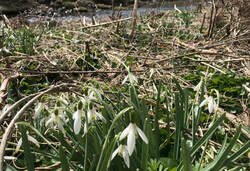Invasive Species
Invasive plant species are a huge problem. They have overtaken giant expanses of the landscape. As they do, they erase the ability for native plants and animals to thrive, and there’s no easy solution to get rid of them. But there's still hope for our favorite natives to survive! In fact, a while back I was out on a walk and I came across a few amazing plants that had beaten the odds among a mess of knotweed and porcelain berry (two of the worst offenders of the invasive mob).
The image above is a small patch of miniature tulips that have survived.
Of all the bulbed plants, snowdrop are by far the most successful. They dot the natural world with little white flowers as early as late February where conditions are right.
Landscape design is all about timing, and knowing how much sun your plants need plus when bloom is critical. An area totally covered by trees is fairly full sun in early spring. Why? Because the leaves haven’t yet come out on the branches and blocked the sunlight. So you can often plant early bloomers, like irises and tulips, under tree cover, because they flower as soon as late March when the sunlight is still plentiful. Of course, by early summer, the trees have shaded the ground and only shade-loving plants will grow.
On my walk along the river, I was reminded of this trick nature plays. By July, the riverbank will be inundated with a thick mat of invasive species – knotweed, mugwort and porcelain berry. They will choke all of a small list of native species out of competition. However, right now, miniature tulips, snowdrop and helleborus are in full color.
No matter how attractive these flowers are, they will quickly be replaced with less desirables. Knotweed has completely overwhelmed most towns and natural areas wherever it can grow….and it can grow just about anywhere with a little moisture and lots of sun. Most often we see people using poison to get rid of these weeds but small flowers like snowdrop and tulips could point to a more natural solution where nature can gang up on them. Most of these invasives don’t like shade and if early growing plants can be used to grow atop the older established invasives (at a faster rate), nature might win the fight.


